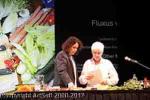Alison Knowles
Alison Knowles
Born: 1933
Biography:
Alison Knowles is an American visual artist known for her installations, performances, soundworks, and publications. Knowles was a founding member of the Fluxus movement, the experimental avant-garde group formally founded in 1962. Criteria that have come to distinguish her work as an artist are the arena of performance, the indeterminacy of her event scores resulting in the deauthorization of the work, and the element of tactile participation. She graduated from Pratt Institute in New York with an honors degree in fine art. In May 2015, she was awarded an honorary doctorate degree by Pratt.
In the 1960s, she was an active participant in New York City's downtown art scene, collaborating with influential artists such as John Cage and Marcel Duchamp. During this time she began producing event scores, or performances that rework the everyday into art. Knowles's inclusion of visual, aural, and tactile elements in her performances sets her art apart from the work of other Fluxus artists.
Alison Knowles was married to Dick Higgins, a leading Fluxist who coined the term intermedia. She has two twin daughters, Jessica and Hannah Higgins. Jessica is a New York-based intermedia artist closely associated with seminal curator Lance Fung, late Fluxus gallerist Emily Harvey, and The International Artists' Museum's Construction in Process. Hannah Higgins is a writer, art historian, and professor at the University of Illinois at Chicago. Both daughters performed and collaborated in original Fluxus related events as youths. Knowles often does performance pieces with members of her family, including Loose Pages, Shoes Of Your Choice, and Beans All Day. Knowles lives and works from her loft in New York City's Soho district, where she was a homesteader beginning in the 1950s.
Transferring from Middlebury College in Vermont, Knowles graduated from the Pratt Institute in 1956. Since her father was a professor at Pratt, she was able to enroll in the school at no cost. During night classes, Knowles studied painting with abstract expressionist Adolph Gottlieb. She admired Helen Frankenthaler and had acquaintance with the work of Jackson Pollock. Franz Kline also taught some of the painting courses. During the day, Knowles studied graphic design and commercial layout. A class taught by painter Richard Lindner proved very influential for Knowles. “What I learned there was that I am an artist. What I should have learned there is that I am not a painter,” said Knowles in a 2006 interview.
In addition to her father, Knowles notes John Cage as another one of her mentors. She knew of Cage through one of his courses taught at the New School for Social Research in the late 1950s. Many of the Fluxus leaders, such as Dick Higgins, George Brecht, Al Hansen, and Allan Kaprow, took the class with John Cage. Knowles’s focus in painting diminished after her show at the Nonegon Gallery in New York, in which she destroyed all of her works in a bonfire behind her brother’s house. This act of destruction led directly to her association with other types of work and eventually with Fluxus. On the first Fluxus tour in 1962, Knowles began to write event scores, which would quickly become a major aspect of the movement.
After participating in the initial Fluxus Festivals in Europe from 1962 to 1963, Knowles returned to the United States and began making objects, some as Fluxus multiples commissioned by George Maciunas, the leader of the movement. Knowles's object-based pieces focus on the audience's tactile and audible interaction with the artwork. While her counterparts targeted the conventions of music, Knowles focused on poetry and the significance of spoken word. During the 1960s, she began to incorporate beans in her art, a common motif in her work. The bean was a unique object to use at a time when other Fluxus artists employed street detritus, readymades, and assemblage objects.
With the invitation of Maciunas, Knowles produced one of her earliest book objects, the Bean Rolls (1963). UnIike a traditional bound volume, the pages of this work are tiny paper scrolls, which the reader may select and view in any order. On each scroll, Knowles printed found texts collected from songs, recipes, stories, science, cartoons, and advertisements. The tin also contains dried beans, which create a rattling sound as the container is handled. In the 1960s, Knowles expanded on this performative aspect of Bean Rolls by staging readings with multiple participants.
In 1967, Knowles created The House of Dust, known as the first computer-generated poem, in collaboration with composer James Tenney. The poem began as a set of four lists written by Knowles. Selecting a phrase from each list would describe a house made of a certain material, in a particular location, illuminated by a light source, and sheltering various inhabitants. She gave the lists to Tenney, who fed them into an early IBM program. The output yielded a permutation completely sequenced by chance. From roughly 10,000 possible stanzas, Knowles selected one quatrain—“a house of dust / on open ground / lit by natural light / inhabited by friends and enemies”—as the basis for an interactive sculpture on the California Institute of the Arts campus in the early 1970s.
More...
Wikipedia link: Click Here








